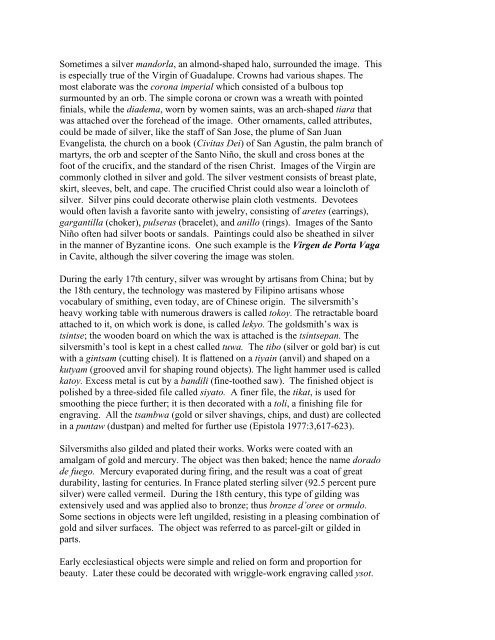METALCRAFT Metalcraft includes all works or objects created from ...
METALCRAFT Metalcraft includes all works or objects created from ...
METALCRAFT Metalcraft includes all works or objects created from ...
Create successful ePaper yourself
Turn your PDF publications into a flip-book with our unique Google optimized e-Paper software.
Sometimes a silver mand<strong>or</strong>la, an almond-shaped halo, surrounded the image. This<br />
is especi<strong>all</strong>y true of the Virgin of Guadalupe. Crowns had various shapes. The<br />
most elab<strong>or</strong>ate was the c<strong>or</strong>ona imperial which consisted of a bulbous top<br />
surmounted by an <strong>or</strong>b. The simple c<strong>or</strong>ona <strong>or</strong> crown was a wreath with pointed<br />
finials, while the diadema, w<strong>or</strong>n by women saints, was an arch-shaped tiara that<br />
was attached over the f<strong>or</strong>ehead of the image. Other <strong>or</strong>naments, c<strong>all</strong>ed attributes,<br />
could be made of silver, like the staff of San Jose, the plume of San Juan<br />
Evangelista, the church on a book (Civitas Dei) of San Agustin, the palm branch of<br />
martyrs, the <strong>or</strong>b and scepter of the Santo Niño, the skull and cross bones at the<br />
foot of the crucifix, and the standard of the risen Christ. Images of the Virgin are<br />
commonly clothed in silver and gold. The silver vestment consists of breast plate,<br />
skirt, sleeves, belt, and cape. The crucified Christ could also wear a loincloth of<br />
silver. Silver pins could dec<strong>or</strong>ate otherwise plain cloth vestments. Devotees<br />
would often lavish a fav<strong>or</strong>ite santo with jewelry, consisting of aretes (earrings),<br />
gargantilla (choker), pulseras (bracelet), and anillo (rings). Images of the Santo<br />
Niño often had silver boots <strong>or</strong> sandals. Paintings could also be sheathed in silver<br />
in the manner of Byzantine icons. One such example is the Virgen de P<strong>or</strong>ta Vaga<br />
in Cavite, although the silver covering the image was stolen.<br />
During the early 17th century, silver was wrought by artisans <strong>from</strong> China; but by<br />
the 18th century, the technology was mastered by Filipino artisans whose<br />
vocabulary of smithing, even today, are of Chinese <strong>or</strong>igin. The silversmith’s<br />
heavy w<strong>or</strong>king table with numerous drawers is c<strong>all</strong>ed tokoy. The retractable board<br />
attached to it, on which w<strong>or</strong>k is done, is c<strong>all</strong>ed lekyo. The goldsmith’s wax is<br />
tsintse; the wooden board on which the wax is attached is the tsintsepan. The<br />
silversmith’s tool is kept in a chest c<strong>all</strong>ed tuwa. The tibo (silver <strong>or</strong> gold bar) is cut<br />
with a gintsam (cutting chisel). It is flattened on a tiyain (anvil) and shaped on a<br />
kutyam (grooved anvil f<strong>or</strong> shaping round <strong>objects</strong>). The light hammer used is c<strong>all</strong>ed<br />
katoy. Excess metal is cut by a bandili (fine-toothed saw). The finished object is<br />
polished by a three-sided file c<strong>all</strong>ed siyato. A finer file, the tikat, is used f<strong>or</strong><br />
smoothing the piece further; it is then dec<strong>or</strong>ated with a toli, a finishing file f<strong>or</strong><br />
engraving. All the tsambwa (gold <strong>or</strong> silver shavings, chips, and dust) are collected<br />
in a puntaw (dustpan) and melted f<strong>or</strong> further use (Epistola 1977:3,617-623).<br />
Silversmiths also gilded and plated their <strong>w<strong>or</strong>ks</strong>. W<strong>or</strong>ks were coated with an<br />
amalgam of gold and mercury. The object was then baked; hence the name d<strong>or</strong>ado<br />
de fuego. Mercury evap<strong>or</strong>ated during firing, and the result was a coat of great<br />
durability, lasting f<strong>or</strong> centuries. In France plated sterling silver (92.5 percent pure<br />
silver) were c<strong>all</strong>ed vermeil. During the 18th century, this type of gilding was<br />
extensively used and was applied also to bronze; thus bronze d’<strong>or</strong>ee <strong>or</strong> <strong>or</strong>mulo.<br />
Some sections in <strong>objects</strong> were left ungilded, resisting in a pleasing combination of<br />
gold and silver surfaces. The object was referred to as parcel-gilt <strong>or</strong> gilded in<br />
parts.<br />
Early ecclesiastical <strong>objects</strong> were simple and relied on f<strong>or</strong>m and prop<strong>or</strong>tion f<strong>or</strong><br />
beauty. Later these could be dec<strong>or</strong>ated with wriggle-w<strong>or</strong>k engraving c<strong>all</strong>ed ysot.
















